Government mail service may be affected by the Canada Post labour disruption. Learn about how critical government mail will be handled.
Norway rat
If a rodent is spotted in the daylight crossing a road or highway, it is unlikely to be a rat and probably is a muskrat.
Most ‘rats’ reported in Alberta are in fact other rodents such as muskrats. Before contacting us to report a rat, view the list below then find about rodents mistaken for rats.
The Norway rat (Rattus norvegicus) is one of the most destructive creatures known to man, and the most common species of rat in the Canadian Prairies. In Alberta, all rats of the genus rattus are provincially regulated nuisances. Larger in size than the mouse, vole, roof rat and pocket gopher, the Norway rat can also be identified by other unique features.
The Norway rat has a wide range of colours – from reddish to greyish brown or completely black on the back and sides. The underparts are tinged with grey to a buff or yellowish-white. White, spotted and ‘laboratory’ rats are only colour variations of the Norway rat.
-
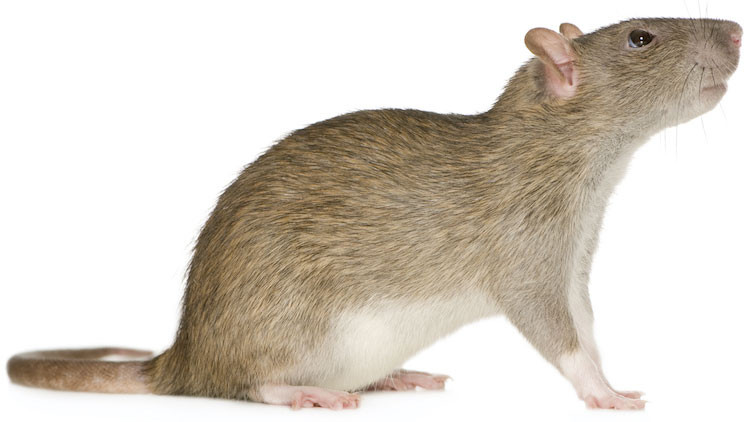 Norway rat
Norway rat- Colour: grey-brown on top, white to light grey underneath
- Size: average body length is 40 cm (15 in); tail is shorter than body
- Ears: when pulled forward, its smaller ears do not cover the eyes
- Tail: cylindrical, ridged and hairless; shorter than body
- Weight: average adult male rats weighs 450 grams (females weigh slightly less)
-
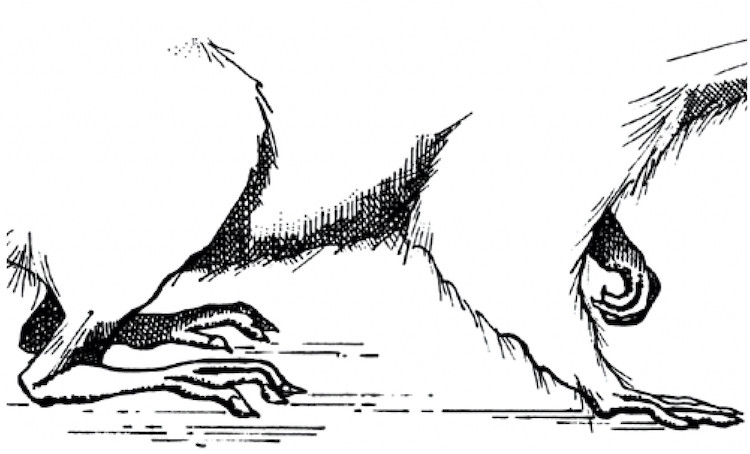 Feet
FeetBoth front and hind feet of the Norway rat are small, delicate and pink.
-
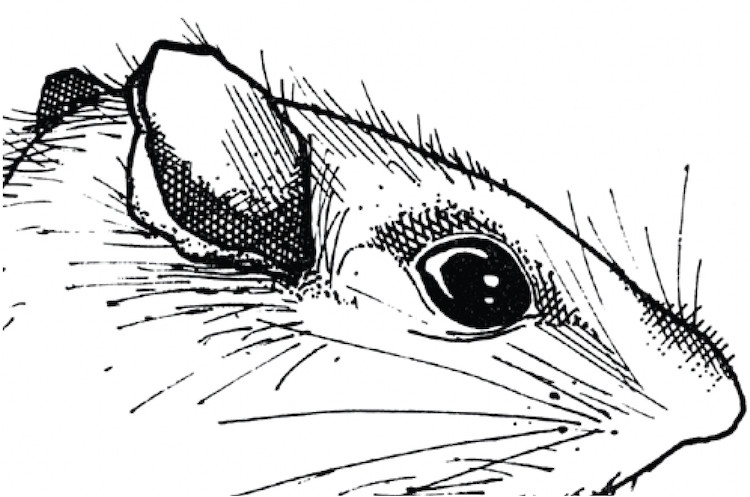 Eyes, nose and ears
Eyes, nose and ears- Eyes: Norway rats have smaller eyes than other rodents. Their eyes are shiny and black.
- Nose: somewhat blunt, pinkish and inconspicuous
- Ears: shorter; not long enough to cover its eyes when pulled down, as in most other rat species
-
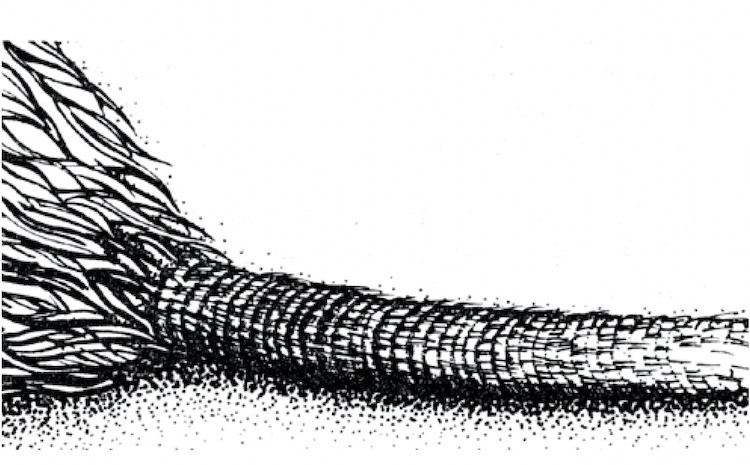 Tail
TailThe most distinguishing feature of a true rat is the tail. The Norway rat’s tail is cylindrical, tapering and nearly hairless. The hairs on the tail are short and bristle-like and grow out from well-defined hairline ridges along the entire length of the tail. The tail is 15 to 22.5 cm (6 to 9 in) long, and is shorter than the body.
Roof rat
Also a regulated pest in Alberta, the roof rat (Rattus rattus) is similar in appearance to the Norway rat. However, the roof rat is slightly smaller and darker, its tail is longer than its body, and its ears are larger. Like the Norway rat, the roof rat has not been able to establish populations on the prairies. However, it is sometimes found in Alberta after arriving via transport vehicles from British Columbia.
-
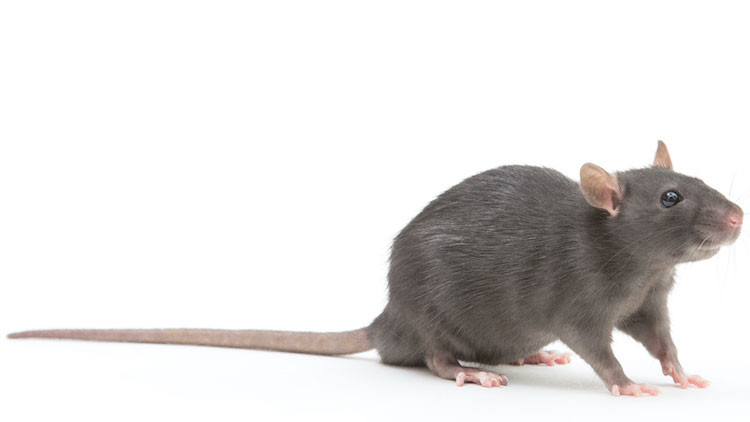 Roof rat
Roof rat- Colour: dark brown/grey/black
- Size: body is 16 to 20 cm (6 to 8 in)
- Ears: when pulled forward, its ears are long enough to cover its eyes
- Tail: longer than body
Signs of rat presence
Burrows and runways
The cylindrical burrow entrance of a Rattus rat in soil or in straw or hay bales measures about 5 to 7.5 cm (2 to 3 in). Unlike native rodents, the burrow entrance of a rat is clean of debris and excavated soil particles. Rats leave well-beaten trails about 5 cm (2 in) wide from their nest areas to food and water sources. Rats often dig lengthy travel runs under objects such as bales, planks, granaries, plyboard and even idle machinery, to move from area to area.
Wall and floor holes
The average size of the circular-shaped rat hole in walls and floors is 5 to 7.5 cm (2 to 3 in) in diameter, but can be considerably larger, depending upon the material. Rats will make holes in walls or floors soon after invasion; wall holes are usually just inches above the floor. Holes in floors are generally close to walls or under supporting skids or poles.
Gnawing
Rats must chew continuously to wear down incisor teeth (front teeth) that grow an amazing 5 to 10 cm (2 to 4 in) per year. Most often, rats will chew materials close by such as plywood, structural woodwork, plastic panelling, frozen ground and even concrete.
Nests and caches
Rattus rats are ground dwellers, so their nests and caches are built on or below ground level. The nest of a rat can consist of almost any material – usually, food remains and other available items such as paper, straw, cardboard, rags or shredded plastic bags. Rats may horde and cache food, which they may or may not eat.
Odours and smudges
The distinctive, musky odour of rats can be easily detected, particularly if rats are confined to a small area. The oily hair of a rat leaves noticeable smudge marks on trails or at hole entrances. The combination of oily hair, dust and dirt results in obvious dark-stained surfaces.
Droppings
A rat can produce up to 25,000 droppings per year. Rats can usually be detected if they have been present for even a short time. Rat droppings are blunt at both ends and the shape and size of an olive pit, measuring 1.25 to 1.5 cm (0.5 to 0.6 in), and shiny black. Droppings fade in time and soon turn to grey-white.
Figure 1. Rodent feces: mouse feces (on left), rat feces (on right).
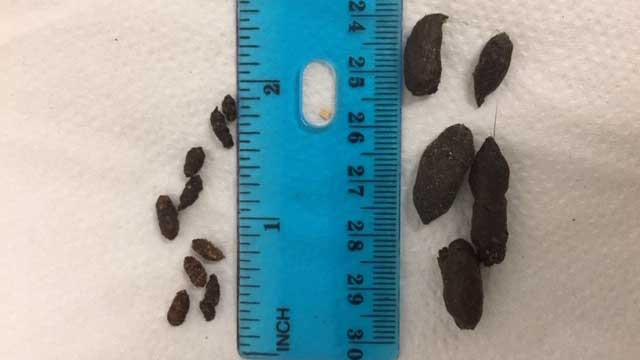
Rodents mistaken for rats
Other small mammals are often mistaken for rats in Alberta. Before you report a rat, it is important to know the difference between rats and other rodents.
Figure 2. Top to bottom, left to right: mouse, vole, juvenile roof rat, pocket gopher, Norway rat.
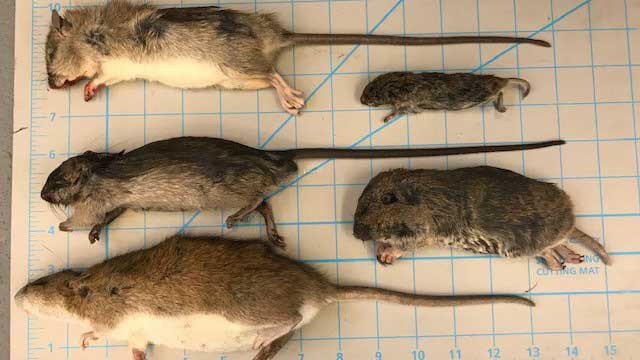
Report a rat
If you see a rat, safely take a picture, note the location, and send us the information one of these ways:
Hours: 8:15 am to 4:30 pm (open Monday to Friday, closed statutory holidays)
- Email: [email protected]
- Toll free: 310-FARM (3276) (in Alberta)
- Phone: 403-742-7901 (outside Alberta)
- Phone your local bylaw Agriculture Fieldmen office.
It is illegal to own pet rats in Alberta.